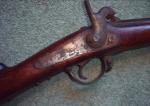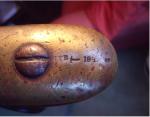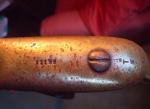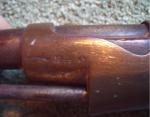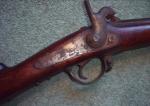
jf42
Past Contributor-
Posts
207 -
Joined
-
Last visited
-
Days Won
1
Content Type
Profiles
Forums
Blogs
Gallery
Events
Store
Everything posted by jf42
-
-
I would be grateful for comments on a percussion musket that seems to be of Russian origin, whose provenance dates the British-Indian NWF in 1899-1900. My great-grandfather worked in Madras from 1872 to 1892. In 1899-1900, he and my great-grandmother returned to visit their daughter and new grandson whose father was CO of a battalion of Sikhs based at Dera Ismail Khan in the "Punjaub". My g.g'father accompanied his son-in law on brigade manoeuvres. The miscellaneous native weaponry discovered in the attic (including a lightweight matchlock, which although worm-eaten survives) was presumably shipped home after this trip. It includes a smoothbore percussion musket that appears to be of Russian manufacture. On the brass furniture there are stamped markings in Cyrillic- птв and (I think) цмс, together with the date '1849' and a serial number [N] 11129. In all but one instance, the numbers and letters are accompanied by the stamped symbol of what I would describe as a geologist's hammer. A brief internet search suggests this might be an Russian M1845 smooth bore, based on a French model of 1842. It has the appropriate raised cheek piece on the inside of the butt. The '1849' is confusing. Is there a chance this might be a local copy made in the NWF region? I'm not sure what use a smooth bore musket might be in the land of the jezail and breechloader, ca 1900.. Perhaps that's why my g.gfather was able to acquire it as a souvenir, but this is not my AOE. While I struggle to upload images, here is a summary of the markings: Butt plate: 11129 птв [Hammer]‘T’ 184 190 [?] Trigger guard plate: цмс [Hammer] ‘T’ 1849 89 Left Hand Firing assembly plate: 18 [Hammer]‘T’ 49 142 [?] Barrel stamp ( at rear): N111[29?] Rear barrel strap: --7[?] 1849 [Hammer]‘T’ птв Mid barrel strap and sling swivel: 119 1823 [?] [Hammer]‘T’ цмс Fore barrel strap and птв [Hammer]‘T’ 1849 69 ramrod housing (Sorry- that was meant to be a table. Formatting is all off.) I should be grateful for any enlightenment. Thanks, JF (This is a cross post from 'Imperial Russia')
-
Imperial Russia Russian Percussion musket- Punjab, 1900
jf42 replied to jf42's topic in Russia: Imperial
Thanks. I had never scrolled that far. "I just stopped at Russia" (N. Bonaparte) -
Imperial Russia Russian Percussion musket- Punjab, 1900
jf42 replied to jf42's topic in Russia: Imperial
-
Imperial Russia Russian Percussion musket- Punjab, 1900
jf42 replied to jf42's topic in Russia: Imperial
-
Imperial Russia Russian Percussion musket- Punjab, 1900
jf42 replied to jf42's topic in Russia: Imperial
-
Imperial Russia Russian Percussion musket- Punjab, 1900
jf42 replied to jf42's topic in Russia: Imperial
-
Imperial Russia Russian Percussion musket- Punjab, 1900
jf42 replied to jf42's topic in Russia: Imperial
-
I would be grateful for comments on a percussion musket that seems to be of Russian origin, whose provenance dates the British-Indian NWF in 1899-1900. My great-grandfather worked in Madras from 1872 to 1892. In 1899-1900, he and my great-grandmother returned to visit their daughter and new grandson whose father was CO of a battalion of Sikhs based at Dera Ismail Khan in the "Punjaub". My g.g'father accompanied his son-in law on brigade manoeuvres. The miscellaneous native weaponry discovered in the attic (including a lightweight matchlock, which although worm-eaten survives) was presumably shipped home after this trip. It includes a smoothbore percussion musket that appears to be of Russian manufacture. On the brass furniture there are stamped markings in Cyrillic- птв and (I think) цмс, together with the date '1849' and a serial number [N] 11129. In all but one instance, the numbers and letters are accompanied by the stamped symbol of what I would describe as a geologist's hammer. A brief internet search suggests this might be an Russian M1845 smooth bore, based on a French model of 1842. It has the appropriate raised cheek piece on the inside of the butt. The '1849' is confusing. Is there a chance this might be a local copy made in the NWF region? I'm not sure what use a smooth bore musket might be in the land of the jezail and breechloader, ca 1900.. Perhaps that's why my g.gfather was able to acquire it as a souvenir, but this is not my AOE. While I struggle to upload images, here is a summary of the markings: Butt plate: 11129 птв [Hammer]‘T’ 184 190 [?] Trigger guard plate: цмс [Hammer] ‘T’ 1849 89 Left Hand Firing assembly plate: 18 [Hammer]‘T’ 49 142 [?] Barrel stamp ( at rear): N111[29?] Rear barrel strap: --7[?] 1849 [Hammer]‘T’ птв Mid barrel strap and sling swivel: 119 1823 [?] [Hammer]‘T’ I should be grateful for any enlightenment. Thanks, JF
-
This is a cross post from Victorian Wars where it has had no takers. As there is more of a focus on headgear at GMIC, I wonder what the gentlemen may think. I would like to understand the reason why, when other Highland regiments adopted the Glengarry bonnet as their regulation forage cap in 1853, the 42nd came to retain the Kilmarnock bonnet. This has obvious parallels with the Black Watch wearing of the blue Balmoral bonnet post-WW2 while other Highland Regts wore the Glengarry, although that was, clearly, to allow wearing of the Red Hackle in No. 1 and No. 2 Dress (Not that the Q.O. Highlanders felt the need to sport their new blue hackle). That was not the case in the 1850s, when the 'red heckle' was only worn with the feather bonnet. Similarly, I would be interested to learn more about the 42nd RHR and 79th Q.O.Cameron Hldrs wearing of the Glengarry bonnet without diced band, while all other Scottish regts (bar the Cameronians post-1881) wore theirs with dicing. As a piece of Highland military garb, the glengarry had hitherto always shown a diced band, pipers excluded, and it was, arguably, once an integral part of the manufacture of the military Highland bonnet. It does not appear to have been anything to do with being Royal Regts. The 79th Cameron Hldrs wore a plain glengarry for twenty years before they were granted their 'Queen's Own' title in 1873. Moreover, the Royal Scots and Royal Scots Fusiliers both wore diced glengarries, although of course, they were Lowland regiments..... In any case, the Black Watch and Camerons both wore diced bands with their full dress feather bonnets, so any symbolism would seem to apply only to the undress Glengarry. "Just to be different" might the obvious theory but I am hoping for something more specific. Any ideas?
-
Post: 323. I thought this must be the frontispiece page of the: 'Historical record of the Fifth Regiment of Foot, or Northumberland Fusiliers: containing an account of the formation of the regiment in 1674, and of its subsequent services to 1837' (one of a series of regimental histories published in the mid-C19th under the name of Richard Cannon, Adjutant General's department). However, I was mistaken. The image, of the same period, nonetheless represents the apogee of the Fifth in its progress towards recognised elite status. A fusilier, corporal and senior NCO (Sgt Major?) are shown with 'grenadier' wings on their coatees, grenadier badges on acoutrements and on their new fur fusilier caps with the unique Fifth red-on-white feathers authorised in 1829. The date on the illustration is a year out, though. It was in May, 1836, that the Regiment was authorised to be "Equipped as Fusiliers, and styled the Fifth Regiment of Foot, or Northumberland Fusiliers", with the honour 'Wilhemstall' to be inscribed on new colours, which were presented at Malta on 14th December by the Governor General, Major General Sir Henry Bouverie (Cannon, 1837) Post 324. An officer in his double-breasted coatee (1830) holding a fur cap with a plume which had me confused for a moment. The red tip appears to be so faded it looks almost white, which made me wonder for a moment if I wasn't looking at an officer of the Seventh, Royal Fusiliers or Twenty third, Royal Welch Fusliiers. The (vibrantly) green facings put me right. This uniform lasted till 1844, when fusilier caps were done away with and fusiliers were ordered to wear the 'Albert' shako, described above, with a large grenade badge on the front, bearing regimental distinctions on the 'ball,' ie. the case of the grenade. In the case of the Fifth, that would be St George and the Dragon, would it not? The worsted 'ball tuft' on the new shako was, of course, red over white. Does that bring us full circle?
-
A footnote to my point about the Fifth not trying to avoid official notice of their non-regulation cap distinction. I should qualify that facetious aside by pointing out that in 1824, when the Regiment were granted Royal approval for "the "White Feather", which for a long series of years has been worn as a mark of distinction by the Fifth Regiment of Foot, being continued to be used by that corps." - they were in the West Indies. The correspondence was between the Adjutant General and Colonel Sir Charles Pratt of the Fifth Regiment in England, The regiment was split between Dominica and, appropriately enough, St Lucia. Can we imagine how gratefully the companies paraded to celebrate in Full Dress with coatees, heavy shakos and newly authorised 12-inch feather? The Regiment was in Ireland when they protested over the white feather for the rest of the infantry and were granted the red tip to the feather of the Fifth. When the title of 'Fusilier' was finally granted to the Fifth (Northumberland) Regt., they were in Malta as part of a ten year tour in the Med between 1832 and 1842 (Gib/Malta/Ionian Isles/Gib). Nice. One wonders how elated the soldiers were to learn of their new right to wear a fur cap on parade. (By the way I should also have mentioned T.C. Mills' invaluable 'British Regiments' site -now archived. Strangely enough, he overlooked the Fifth's elevation to Fusilier status in 1836.)
-
Ok.Your first man is in fact wearing the so-called 'Regency' or 'Prussian' shako that in 1816 replaced the eminently practical 1812 shako ('Belgic'; 'Waterloo') shown in your last post. That quality alone would explain why the 1812 cap lasted only four years before being replaced by the expensive and top-heavy "Regency"-7 1/2 inches high, 9 inches across at the top and with a hackle-feather 'plume' 12 inches long. In 1822, another inch was added to the shako's height and officers' lapels were shaped into the fine, padded 'plastron' effect, shown in this illustration. The Fifth's white feather was at this stage still unofficial- not that they were trying to dodge attention! Indeed, the 12-inch plume may have been why the powers finally decided to ask the Regiment what the authorisation was for their 'different' feather. It had become impossible to ignore. In fact, though, many non-uniform distinctions dating from the French wars, or before, were being questioned at this time; partly because of concern about mounting expense from non-regulation embellishments. Most seem to have been sanctioned- red bonnet feathers, exclusive use (42nd, 1822), white feathers (5th, 1824), red light coy feathers (46th, 1833), black collar 'flashes' (23rd, 1834). Or perhaps we just remember the one's that were permitted! This 'Regency' uniform lasted till 1829, when the double-breasted coatee was introduced for officers and all ranks in the Guards. Line soldiers still wore a single-breasted laced coatee. This was accompanied by the "Bell-Top" shako, 6 1/4 inches high and an impossible 11 inches in diameter across the crown; looking very impressive in illustrations but cumbersome and uncomfortable in practice. Hardly any surprise the forage cap was worn for service in the field. Shortly after, a white 'plume' -12 inches long for officers- was ordered for all infantry apart from Lights and Rifles who, in a rare burst of practicality had been authorised a green 'ball tuft'. This provoked the Fifth's protest. Five years later, sense prevailed again, in that the white feather, by then only 8 inches long (and now tipped with red for the 5th Northumberland regiment) was replaced with a white 'ball tuft' ( tipped in red, etc., etc.). The next year the Fifth became Fusiliers. The gentleman in your second print would appear to be a field officer in 1829, immediately before the red tip was authorised for the Fifth's white shako plume. (This is mostly coming, by the way, from Michael Barthorp- 'British Infantry Uniforms since 1660' with background from Robert Wilkinson Latham- 'Scottish Military Uniforms.' I have also learned a great deal from the good folk at Victorian Wars Forum as well as RevList and RWProgressive at Yahoo groups. )
-
Well, these prints of 1812 uniforms are interesting because the 5th (Northumberland) Regt were only granted their red-tipped feather in1829. Previously, they had worn a white feather, which as many of you will know, was said to be a trophy from the battle of La Vigie on St Lucia in December, 1778, when a small British force inflicted a bloody defeat on the numerically superior French force attempting to recapture the island. Traditionally, the distinction commemorates the picking up of white feathers from the hats of fallen French troops. (It seems battalion coys in the French army, known as fusiliers, had been ordered to wear white feathers in their hats from 1776, grenadier coys, white and red; chasseurs (light coys), green and white. It would appear these were also worn in tropical service uniforms.) There is no contemporary record of this happening but the battalion officer and man of the Fifth in Daye's watercolour from c.1791 are shown wearing white feather in their hats, indicating the custom was well established within twenty odd years of the battle. The Fifth's white feather distinction was finally authorised in 1824, backed up by testimony, (albeit a little ambiguous*) from General Lord Harris, who was a veteran of the campaign. This put the Fifth on a par with the Fusiliers and Flank coy grenadiers, who had been wearing a white feather in their hats since the AWI, and the First Foot Guards, who had worn a white plume in their bearskin caps since they were awarded the title of Grenadier in 1815. When it was decreed in 1829 that all line infantry should wear a white feather on their shakos, "rifle and light infantry regiments excepted," the Fifth protested that this would extinguish their "distinction of wearing a feather different from the rest of the army" (What the Guards, Fusiliers and grenadiers said about this, I'm not sure). As a result, the powers decreed,"adverting to the gallantry of the exploits which contained for that corps its original distinction, his Lordship has been pleased to submit to his Majesty, that the Fifth regiment shall, in future, wear a feather half red and half white, the red uppermost, instead of the plain white feather worn by the rest of the army per the 1829 order, as a peculiar mark of honour, whereby its former services will still be commemorated, and a perpetual incitement be afforded to a continuance of its good conduct." So, Simpkin is about seventeen years too early in his depicting men of the Fifth (Northumberland) Regt wearing red-over-white shako plumes. A curious error. I'm also wondering if the Pioneer's 'Fusilier' cap is not more of a mid-19th century shape but I would straying into an area I am not too familiar with. {*Note: (1824) Lord Harris was quoted as saying "All he could himself remember, at that distant period, relative to the white feather, was, that after the action of St. Lucie, when the men of the 5th were taking the feathers from the hats of the Frenchmen who were killed, they said to each other “No one will dispute our right to the white feather after this day.” I can vouch that, for the twenty-six years I was with them, from ensign to lieutenant-colonel, they wore the white feather without a stain [sic]" As Harris was a Major in 1778, this could be construed as saying the 5th had been wearing the white feather before St Lucia. He had been an ensign in 1762 when, coincidentally, the Fifth had won an earlier set of battle trophies in the form of the fur caps of the Grenadiers de France and the Grenadiers Royaux at Wilhemstahl. These would later be worn on parade to the annoyance of local generals. as in Philadelphia, Jan 1778. However, the good general also confessed that "at that distant period", "his memory, never very good, could now be of so little service to his old corps." He might have momentarily confused the two trophies in his mind.
-
If I keep asking, will these images keep coming? This picture is of the Vth in the last years of the coatee, wearing the first so-called 'Albert' pattern shako worn between c.1844-1855. The officer's broad-crowned forage cap dates the scene to before 1852. Introduced in 1843, the most notable feature of the 'Albert' shako was the second peak at the rear, similar to a contemporary Austrian pattern (perhaps more responsible for the design than Prince Albert). It was worn by the troops sent to the Crimea, though it was little seen after the initial action march to Sevastopol and the battle of the Alma. Troops apparently quickly found ways of 'losing' their caps which, IIRC, would reappear stuffed with earth on the parapets of field fortifications. Even before it was being disposed of in great numbers by the men on duty in the trenches at Sevastopol, the shako had proved heavy and uncomfortable. It was described as "inconvenient' in the Sikh Wars (What does that say about the previous model Bell-Top?) and not surprisingly many battalions campaigned in their forage caps. Nonetheless, it took another five years for a replacement to be ordered to complete the new, 'modern' uniform that was authorised too late for the Crimea. This was the first, double-breasted tunic introduced in 1855, accompanied by the second 'Albert' pattern shako. The cap was still peaked fore-and-aft but lower than the previous model and with the band sloping back from the brow to the occiput, giving it a distinct tilt forward, recalling for some the shako and kepi forage cap of the contemporary French army. Unfortunately, the 2nd pattern 'Albert' shako was not successful either and it was quickly replaced by the blue, 'quilted' shako shown in your previous post. It was this 1861 shako that the Fusiliers and Light Infantry wore with the falling horse hair plume in full dress.
-
A beautiful print. Thank you. The shako is the so called 'quilted' shako, authorised 1861-69, that replaced the unsuccessful 2nd 'Albert' introduced after the Crimea. The fusilier on the left carries an Enfield percussion-fired, muzzle-loading musket which was replaced by the Snyder breech-loader from 1866. Somebody might be able to comment on the tunics. As far as I am aware, fusiliers and light infantry (except HLI, I think) adopted hanging plumes with the 2nd Albert from 1856 while line continued wearing white-over-red 'ball tufts, ' in the main, with Royal regiments wearing all-red from 1870. You are right, unlike the Vth, the Royal Fusiliers and Royal Welch Fusiliers wore all-white plumes until the fur cap was re-introduced in 1866. Light Infantry continued with their green hanging plumes until 1874. Is it me or do all the three men to the right look related?
-
Sorry to take so long to respond to this, I had been hoping to condense information I had but have not had the time. I think 1648 would be too early for either grenadier or fusilier symbols. I wonder if some digits were reversed and that should read '1684'? My understanding is that the earliest record of units in Britain that we can recognise as grenadiers comes from1677-78 when Earl of Mar formed companies of grenadiers at Stirling Castle. It seems that Mar's "Greybreeks' were designated Scots Fuzileers in 1685. In the same year, The Royal Ordnance Regiment with twelve coys of fusiliers and one of miners was formed at The Tower. The title was changed to the Royal Regiment of Fuzileers in 1691 at which time they lost their ordnance role. My interest lies in understanding how the grenade came to be a Fusilier symbol, whether it came from the early association with Artillery (and their flaming shell/grenade badge) or from an identification of Fusiliers as elite infantry, effectively the equivalent of European grenadier regiments. This was clearly the status that the Vth sought over seventy odd years until it was finally granted in 1836- and which was granted to the 20th Regiment in 1881 and the Royal Warwickshire in 1963.
-
LANCASHIRE FUSILIERS BERET
jf42 replied to Mervyn Mitton's topic in Great Britain: Militaria: Badges, Uniforms & Equipment
A tangential question to a 1950s beret and hackle: How did the 20th Foot after 99 years as the East Devonshire Regiment become both Lancashire and Fusiliers in 1881? Did the 'Fusilier' title stem from a particular episode or campaign? -
Tam o'Shanter...or what is it?
jf42 replied to MASteel's topic in Great Britain: Militaria: Badges, Uniforms & Equipment
That's an impressive level of detail! If your assessment is correct, that would make our man a rifleman of the 2nd Battalion (More Scottish Rifles than Cameronians ) in Mesopotamia from 1918 or in India on the NWF from January 1922. The 2nd Bn remained on the NWF till January 1930- (with a quick dip into Kurdistan in 1923) (See: archived regiments.org < http://web.archive.o...-inf/090-1.htm>) The only question mark over that conclusion is the post card with "Post Card" in English, French, Italian, and Spanish on the back, which suggests a more Mediterranean, European focus. Taking that into consideration, the 2nd Bn's tour in Palestine in 1937 would be a more persuasive hot-weather posting. In any case, at least the shoulder titles tell us the picture isn't from a pre-1914 posting. As regards the photo of the two Cameronian jocks in the east, the man with the slouch hat in the middle need not be an Australian- (did they serve in India/ Burma?). He could be a British soldier, even a Cameronian, wearing the felt hat issued to replace the Wolseley for field service in India/Burma during WW2 (Is that an Aussie face or a Scottish face?). The 1st Cameronians served in India from 1931 and then in Burma against the Japanese until the battalion was reduced in 1946 and amalgamated with the 2nd to form a one battalion regiment. -
Tam o'Shanter...or what is it?
jf42 replied to MASteel's topic in Great Britain: Militaria: Badges, Uniforms & Equipment
It's just possible there are tartan flashes there but obscured by the lack of contrast in the photo. Unless flashes were only worn on the ToS in temperate climes, but I can't think why that might be. It would seem that the black hackle didn't transfer from the Wolseley helmet to the Balmoral and subsequently the ToS till after the end of WW2 and the reduction to a single battalion. Up until then, it appears to have been purely a distinction worn in hot climates where at least one of the battalions had been serving during inter war years; indeed, since the beginning of the century apart from the four years of WW1. -
Tam o'Shanter...or what is it?
jf42 replied to MASteel's topic in Great Britain: Militaria: Badges, Uniforms & Equipment
Makes a change hearing the Cameronians not be the butt of the joke, but as far as I can see, from family experience at any rate, the Black Watch had precious little good to say about anyone! Cameronians, very bad blood, Royal Scots -'First and Worst', Scots Guards-'Woodentops' ( always poaching the taller men), and those upstart Camerons had been treading on the Royal Highland regiment's coat tails ever since they persuaded Queen Victoria to grant them "Queens Own" status, wore a plain glengarry and got themselves a blue hackle! My father was always being rude about Camerons of his aquaintance at Highland Brigade. All his superiors, of course. And all in fun, of course. -
Tam o'Shanter...or what is it?
jf42 replied to MASteel's topic in Great Britain: Militaria: Badges, Uniforms & Equipment
The hair looks wrong for pre-WW1, to me; the shorts, too. I may be wrong. But rather than the 2nd Bn's posting to Malta 1910-1914, perhaps their visit to Palestine in 1937 is a better bet. I guess a black shirt is unlikely, all things considered, but dark green can't have helped either in what was clearly a very hot place. As for the shoulder titles and other distinctions between 1st and 2nd Bns The Cameronians, this is a new area for me and I imagine there might be someone a lot better qualified to comment. I am also, with pleasure, having to peel away years of prejudice, being a son of The Black Watch !


